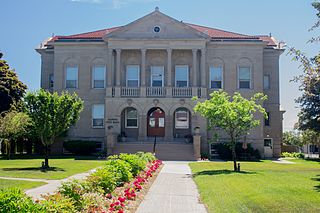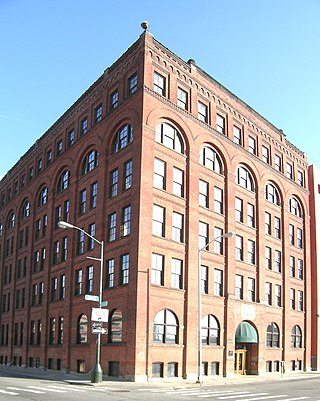
A cement is a binder, a chemical substance used for construction that sets, hardens, and adheres to other materials to bind them together. Cement is seldom used on its own, but rather to bind sand and gravel (aggregate) together. Cement mixed with fine aggregate produces mortar for masonry, or with sand and gravel, produces concrete. Concrete is the most widely used material in existence and is behind only water as the planet's most-consumed resource.

Alpena is a city in the U.S. state of Michigan. It is the county seat of Alpena County, and is the only city within the county. The population was 10,197 at the 2020 census, making it the third most populated city in the Northern Michigan region, after Traverse City and Cadillac. The city is surrounded by Alpena Township, but the two are administered autonomously. It is the core city of the Alpena micropolitan statistical area, which encompasses all of Alpena County and had a total population of 28,907 at the 2020 census.

Building material is material used for construction. Many naturally occurring substances, such as clay, rocks, sand, wood, and even twigs and leaves, have been used to construct buildings. Apart from naturally occurring materials, many man-made products are in use, some more and some less synthetic. The manufacturing of building materials is an established industry in many countries and the use of these materials is typically segmented into specific specialty trades, such as carpentry, insulation, plumbing, and roofing work. They provide the make-up of habitats and structures including homes.
Prefabrication is the practice of assembling components of a structure in a factory or other manufacturing site, and transporting complete assemblies or sub-assemblies to the construction site where the structure is to be located. Some researchers refer it to “various materials joined together to form a component of the final installation procedure“.

A concrete block, also known as a cinder block in North American English, breeze block in British English, concrete masonry unit (CMU), or by various other terms, is a standard-size rectangular block used in building construction. The use of blockwork allows structures to be built in the traditional masonry style with layers of staggered blocks.

The Detroit and Mackinac Railway, informally known as the "Turtle Line", was a railroad in the northeastern part of the Lower Peninsula of the U.S. state of Michigan. The railroad had its main offices and shops in Tawas City with its main line running from Bay City north to Cheboygan, and operated from 1894 to 1992. In 1946, it became the first all diesel haul railroad in the United States.

The Crescent Brass and Pin Company Building is located at 5766 Trumbull Street in Detroit, Michigan. It was listed on the National Register of Historic Places in 2003. It is currently known as the Research Lofts on Trumbull.

The Globe Tobacco Building is a manufacturing building located at 407 East Fort Street in Downtown Detroit, Michigan. It is the oldest tobacco manufactory extant in Detroit, and is listed by the National Register of Historic Places.

The Frederick Stearns Building is a manufacturing plant located at 6533 East Jefferson Avenue in Detroit, Michigan. The building was listed on the National Register of Historic Places in 1980 and designated a Michigan State Historic Site in 1981. It has been converted to condominiums.

The Alger Theater is a theatre located at 16451 East Warren Avenue in the MorningSide neighborhood of Detroit, Michigan. It is one of only two remaining intact and unchanged neighborhood theaters in the city of Detroit. It was listed on the National Register of Historic Places in 2005.

The Edison Portland Cement Company was a venture by Thomas Edison that helped to improve the Portland cement industry. Edison was developing an iron ore milling process and discovered a market in the sale of waste sand to cement manufacturers. He decided to set up his own cement company, founding it in New Village, New Jersey in 1899, and went on to supply the concrete for the construction of Yankee Stadium in 1922.

The Iron County MRA is a Multiple Resource Area addition to the National Register of Historic Places, which includes 72 separate structures and historic districts within Iron County, Michigan, United States of America. These properties were identified and placed on the Register in 1983, with the exception of one property that was placed on the Register in 1993.

The Campbell–DeYoung Farm is a farmstead located at 9510 East Cherry Bend Road in Elmwood Charter Township, Michigan. It is currently operated as a recreational area by the Leelanau Conservancy, and known as the DeYoung Natural Area. It was listed on the National Register of Historic Places in 2011.
The Besser Museum for Northeast Michigan is a community museum serving Alpena County and surrounding counties in the U.S. state of Michigan. Alpena is a port city on Lake Huron. The museum defines its role broadly — to preserve, protect and present history and culture closely connected with the heritage of Northern Michigan and the Great Lakes. The museum includes a small publicly-owned planetarium.
Jesse Besser (1882–1970) was an inventor and manufacturer from Alpena in the U.S. state of Michigan. He is best known for inventing, and supervising a series of improvements to, a tamping machine used to rapidly press wet, flexible concrete into blocks, thereby making possible a new generation of applications in masonry construction. For decades, Besser block was a worldwide standard term for masonry construction blocks. The Alpena-based Besser Company, which inventor Besser ran for many decades, manufactured these machines and made a fortune for Besser and his family. Concrete block became a feature of worldwide construction solutions in World War II and following years. Commencing in 1964, Besser turned over part of his assets to the newly founded Jesse Besser Museum, now known as the Besser Museum for Northeast Michigan, as an endowment.
Besser Mfg. Co. v. United States, 343 U.S. 444 (1951), is a 1951 patent–antitrust decision of the United States Supreme Court in which the Court upheld a ruling that the dominant U.S. manufacturer of concrete block–making machines violated the antitrust laws when it acquired its two principal competitors, bought important patents, made bad–faith threats of patent infringement suits, and entered into patent licensing agreements in which the parties were given veto powers over any prospective additional licensees. The Supreme Court approved the district court's grant of compulsory, reasonable–royalty licensing of the patents and compulsory sales of patented machines, holding that such relief "is a well–recognized remedy where patent abuses are proved in antitrust actions, and it is required for effective relief."

The I.O.O.F. Centennial Building is an historic building located at 150 East Chisholm Street in Alpena, Michigan. It was listed on the National Register of Historic Places in 2015. It dates back to 1876 and is “an excellent example of late Victorian commercial architecture.”

The Warren Motor Car Company Building, also known as Lincoln Motor Car Company Building, is a factory located at 1331 Holden Street in Detroit, Michigan, now part of the Lincoln Street Art Park. It was listed on the National Register of Historic Places in 2020.

The Coignet Stone Company Building is a historical structure in the Gowanus neighborhood of Brooklyn in New York City, at the intersection of Third Street and Third Avenue. Designed by architects William Field and Son and constructed between 1872 and 1873, it is the city's oldest remaining concrete building. The Coignet Building is the last remaining structure of a five-acre concrete factory complex built for the Coignet Agglomerate Company along the Gowanus Canal.

The East Ludington Avenue Historic District is a residential historic district located in the 400-800 blocks of East Ludington Avenue in Ludington, Michigan. It was listed on the National Register of Historic Places in 2022.


















